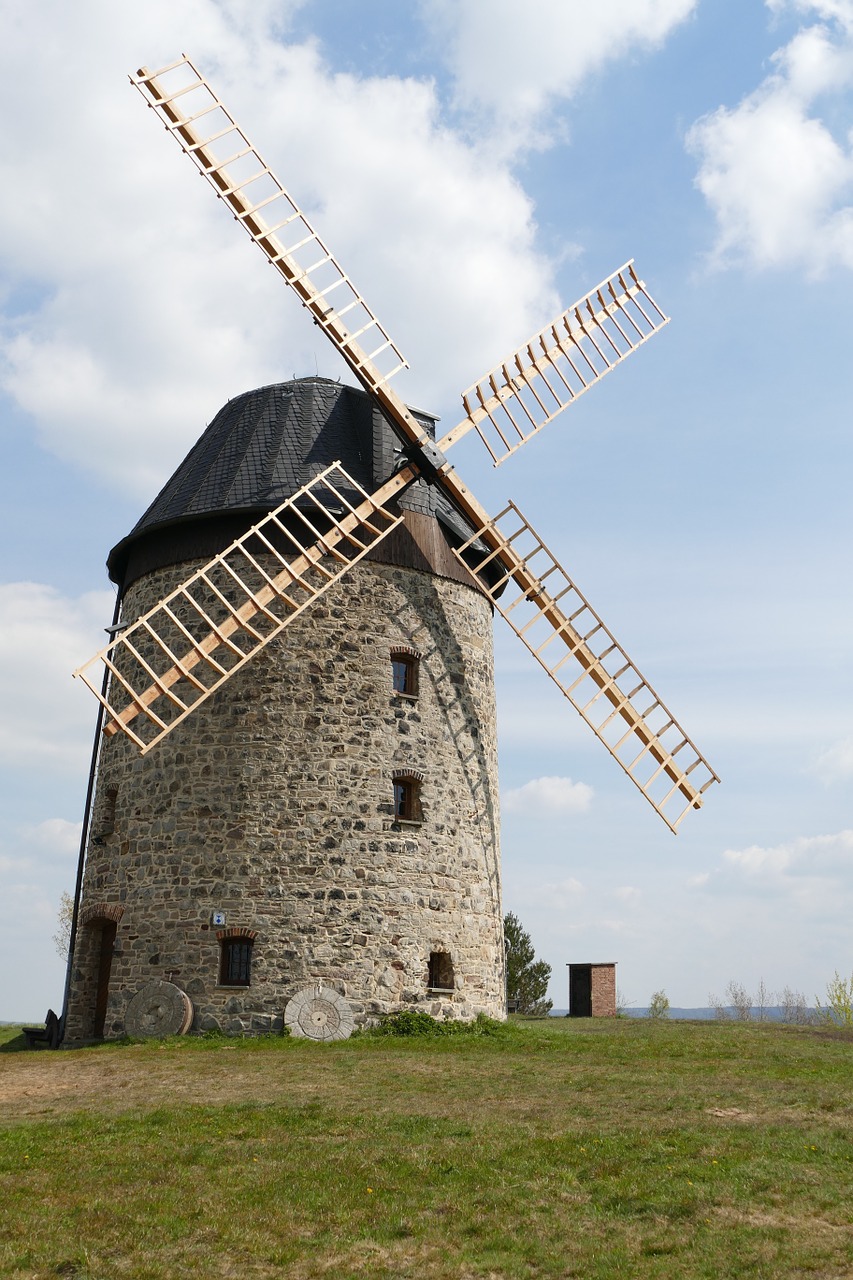Windmill

|
Contents |
[edit] Introduction
Traditionally, a windmill was a building/structure which used wind power to grind wheat or corn or to perform other repetitive tasks. Power was produced by the action of a wheel of sails or vanes which were forced to rotate by the wind. This rotation was connected to a shaft (either horizontal or vertical) which in turn rotated and was connected to equipment that performed the required work, whether grinding or pumping water.
However, as power generation is at the mercy of the wind and throughout history, where a constant power source was required or where the location was in a river valley, a water wheel (producing power by a similar action) was often used instead.
Windmill sails have varied through time. A common method was to cover a timber lattice-framework with sailcloth. Alternatively, in colder climates, the sailcloth was replaced by wooden slats which could be more easily handled in freezing conditions.
[edit] History
There is much uncertainty concerning where and when windmills originated. They go back thousands of years but it is a strange quirk of history that they were probably unknown to the Greeks and Romans. No explanation has been given for this despite the fact that both cultures fully understood and could harness sail power for boats.
Windmills were known to the Islamic world – notably Persia – as early as the 10th century AD, some say even earlier. In Europe, the earliest instances were in France, England, Germany and the Netherlands in the late 12th century. By 1191, windmills became a recognised element of European society and Pope Celestine III ruled that owners of windmills should pay tithes. The next 100 years saw windmills become common features in the landscapes of northern Europe.
Medieval windmills were of the post-type which involved the entire structure being balanced on a very large vertical post and rotating to face the wind. Today, these are seen as daring feats of engineering given that the entire structure rotated on a single fulcrum.
It took another two centuries to see the introduction of the tower mill which had a fixed (usually masonry) substructure and a rotatable cap. This allowed the tower to be made taller and the sails to be made longer. Keeping the cap facing the wind was initially achieved manually using winches but this could later be achieved automatically by the use of a fantail mounted at the rear of the mill and at right angles to the sails.
A later development was the Smock mill, a timber-framed structure clad in boards and thatched or covered by other materials such as metal and slate. Typically, octagonal in plan, the lighter weight of such structures made them suitable for locations with unstable soils, especially for draining marshland and other areas.
The jib sail is seen in some of the Greek Islands and other parts of the Mediterranean and consists of isosceles triangle-shaped sails. Sails can be adjusted to suit the wind force but the mill has to be stopped to achieve this.
[edit] Modern windmills
[edit] 
[edit] Multi-vane propeller
The multi-vane propeller-type of windmill is a common sight in the US and comprises a vertical rotor with a wheel of around 15 or more segment-shaped blades. They rotate about a horizontal shaft and must be orientated into the wind to achieve optimum power. This is achieved in a similar way to the fantail system on traditional tower mills by the use of a vertical vane or rudder that produces the required turning moment. This type of mill is commonly used on farms to pump water when electricity is unavailable, and also to charge batteries. One of the largest multi-vane windmills has an overall diameter of 53m and a maximum blade width of 4.9m.
A similar principle is exploited by modern-day wind turbines which have propellers to generate commercial, residential and industrial electricity. For more information see: Wind turbine.
[edit] S-rotor
The S-rotor type of windmill is mounted on a vertical shaft and converts the force of the wind into torque. It typically comprises an S-shaped assembly rotating about a vertical axis which, because of the circular configuration, catches the wind and so develops the same power independently of wind direction.
[edit] Related articles on Designing Buildings Wiki
- Carbon capture and storage.
- Energy Act.
- Energy storage.
- Geothermal pile foundations.
- Ground energy options.
- Large scale solar thermal energy.
- Nimbyism.
- Renewable energy.
- Rainwater harvesting.
- Sustainability.
- Solar photovoltaics.
- Solar thermal energy.
- The future of UK power generation.
- Why the UK needs to support emerging tech like energy storage.
- Wind farm.
- Wind turbine.
- Windcatcher.
Featured articles and news
Professional practical experience for Architects in training
The long process to transform the nature of education and professional practical experience in the Architecture profession following recent reports.
A people-first approach to retrofit
Moving away from the destructive paradigm of fabric-first.
International Electrician Day, 10 June 2025
Celebrating the role of electrical engineers from André-Marie Amperè, today and for the future.
New guide for clients launched at Houses of Parliament
'There has never been a more important time for clients to step up and ...ask the right questions'
The impact of recycled slate tiles
Innovation across the decades.
EPC changes for existing buildings
Changes and their context as the new RdSAP methodology comes into use from 15 June.
Skills England publishes Sector skills needs assessments
Priority areas relating to the built environment highlighted and described in brief.
BSRIA HVAC Market Watch - May 2025 Edition
Heat Pump Market Outlook: Policy, Performance & Refrigerant Trends for 2025–2028.
Committing to EDI in construction with CIOB
Built Environment professional bodies deepen commitment to EDI with two new signatories: CIAT and CICES.
Government Grenfell progress report at a glance
Line by line recomendation overview, with links to more details.
An engaging and lively review of his professional life.
Sustainable heating for listed buildings
A problem that needs to be approached intelligently.
50th Golden anniversary ECA Edmundson apprentice award
Deadline for entries has been extended to Friday 27 June, so don't miss out!
CIAT at the London Festival of Architecture
Designing for Everyone: Breaking Barriers in Inclusive Architecture.
Mixed reactions to apprenticeship and skills reform 2025
A 'welcome shift' for some and a 'backwards step' for others.





















